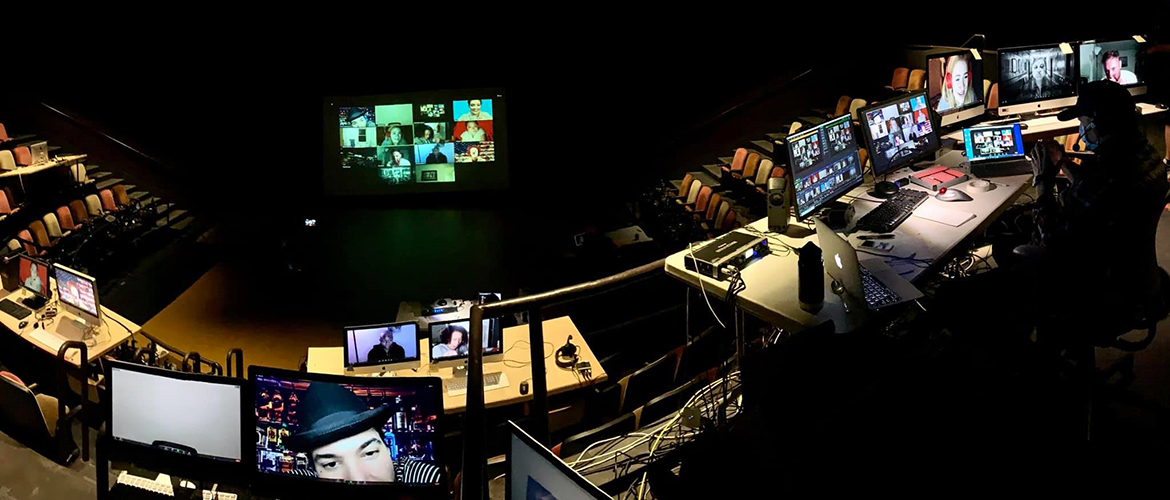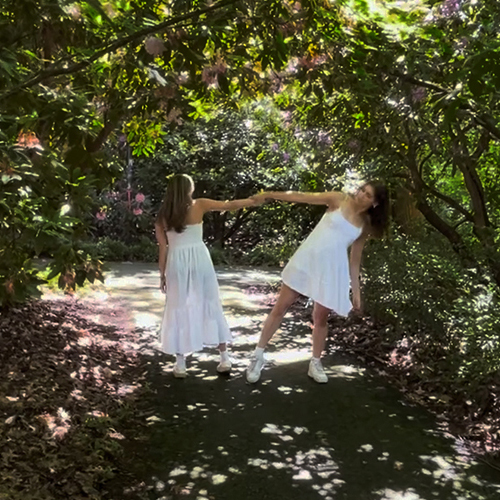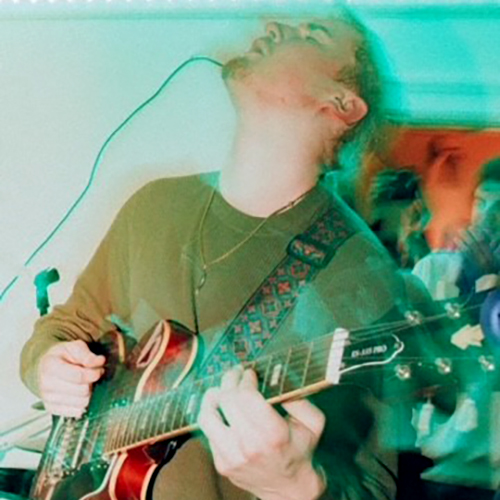“There could be one of you; there could be hundreds of you,” actor Antonio Mitchell says to an unseen audience toward the beginning of So Far So Good, presented by the UW School of Drama in October. With that line, Mitchell acknowledges the strange landscape that he and other students in the performing arts have been navigating during the pandemic.
So Far So Good was presented live, online, which was a first for everyone involved. Eleven actors — all graduate students in the UW's Professional Actor Training Program — performed from their homes, with a team of technical staff coordinating feeds from all those locations. To complicate matters, the show’s director, Libby King, had just joined the School of Drama as an assistant professor a month earlier.
“I was nervous,” admits King. “This first time I met all the students, it was over this weird technology in this strange moment.”
Fortunately, King came to the UW with extensive experience creating theater that pushes boundaries. She spent years as a member of The TEAM, an acclaimed New York theater company that creates “devised” productions — shows developed collaboratively by those involved rather than built around an existing script. King describes devised theater as “a very intentional choice to create a space that gives equal voice to each person in the room.”
A Devised Approach
King planned So Far So Good as a devised production as well, posing the question, “What is the current American moment?” as a jumping-off point for the students, who then spent about 10 weeks creating characters, developing content, and rehearsing. Given the tumultuous events of 2020, the students had plenty of raw material to work with.
Weekly prompts provided more inspiration, including an assignment to write about something born during the pandemic and something that had died. “One performer brought in a piece about hugging, and it was related to her father,” recalls King. “It was beautiful.”

The actors also found inspiration in the work of their cast mates. “In a generative process like this one, each person brings new material to every rehearsal, so you get a wonderful window into each performer’s unique artistry and aesthetic,” says actor Joellen Sweeney. “In a way, that’s also the most difficult part of this kind of work — we created so many interesting things, we could have taken the show in almost any direction.”
Over time, the actors focused on a small group of characters, exploring how they grapple with events during a 12-hour period that begins with the vice presidential debate. Those characters include a bartender, a depressed birthday boy, several exhausted superheroes, a clown, the ghost of a murdered actress, and more.
In one scene, Sweeney — in a grey wig and dowdy clothes — knits a massive red afghan and introduces herself as Margot, the last survivor of a stitch-and-bitch circle. In a thick Wisconsin accent with a matter-of-fact tone, Margo shares that the afghan is “a red-hot blanket of my rage.” Sweeney wanted to explore how such a character would respond to the current moment. “And I hoped that she would make people laugh a little in the process,” she says.
...each person brings new material to every rehearsal, so you get a wonderful window into each performer’s unique artistry and aesthetic.
Amber Walker chose a more autobiographical approach. In a powerful monologue, her character shares family memories of growing up Black in America. “I use theater making, creation, and devising as a way of processing information about myself and things that I’m curious about in the world, and vocalizing them to an audience in a voice that is uniquely my own,” says Walker. “This monologue was my first step in doing that. I grappled with what kind of information to include because I didn’t want to come off as a victim. I wanted to be empowered. I’m very proud of what I ended up with, and I’m excited to delve deeper into my voice and what I have to share.”
Designing at a Distance
The set for Walker’s performance was her bedroom. Other cast members also performed from their bedrooms — or kitchens or bathrooms or hallways. Annie (Da-hye) Bang, who earned a BA in interdisciplinary visual arts from the UW and is now a graduate student in scenic design, took the lead in selecting locations and ensuring that the disparate settings meshed well on screen.
Unable to visit the actors’ homes in person, Bang had each actor walk her through their space using a phone or tablet. She noted everything from the size of rooms to the lighting to any interesting angles, and asked plenty of questions. “I might ask, ‘Do you have a floor lamp or desk lamp you could use here? Do you have a flashlight? Can you bring the camera into the kitchen? Can you place it on the table so I can see that angle? Can you turn off the lights and open the freezer so we can see what that light looks like?’ The process was trial and error until we found what would work.”

Bang also designed costumes for the show. As the cast developed their characters, she sketched costume ideas, and then worked with the School of Drama’s Costume Shop to find clothes and accessories in its collection that could be reworked. When necessary, costumes and props were ordered online.
“It was a little bit challenging that we couldn’t actually see the actors in the space together to try out all the costumes,” says Bang. “To be prepared, we sent them multiple options and picked which worked best on camera.”
Presenting the Online Performance Live
While managing all those costumes and sets from a distance was a challenge for Bang, production manager Ryan Gastelum’s role was equally daunting. Gastelum was responsible for managing production staff in executing the technical aspects of the production, which included mixing the live feeds from actors’ homes in various combinations, and then streaming everything to Zoom for the live performances. (Some prerecorded segments were also part of the mix.)

“We’re doing something none of us have ever done before,” says Gastelum. “The production staff has been stellar in figuring this out and helping us imagine and execute this plan.”
A makeshift broadcast studio in the Floyd and Delores Jones Playhouse included 11 monitors – one for each actor’s feed — that flanked a streaming computer, which processed the streams coming from the actors. The team used specialized software, vMix, which the School of Drama purchased with funds from the Floyd and Delores Jones Playhouse Endowed Support Fund. The endowment also funded streaming kits for the actors, which included iPads and other helpful equipment.
“The software and other equipment was purchased not just for this show but for upcoming productions as well,” says Gastelum. “We’ll be using it as long as we’re in this pandemic world and probably even beyond. It’s really stretching the School’s capabilities to engage with new types of media and new types of shows.”
Why go through all this trouble for a live performance, when pre-recording the performance would be far simpler? King says the energy in a live performance — even streamed on YouTube — is important. “Anything can happen in a live performance,” she says. “It keeps us on our toes.”
Of course one thing a live performance on Zoom cannot replicate is the actors’ connection with the audience, which is so vital to most theater experiences. That’s a challenge that technology has not yet addressed. Each actor has had to cope with that absence.
“It’s very challenging to perform without the energy exchange we’re used to between the performer and audience,” says Sweeney. “Before each performance, I spent some time during my warmup imagining the audience and renewing my intention to be with them, wherever they were in the world. And that helped a little bit.”
. . .
The School of Drama’s next production is a film directed by Jeffrey Fracé, assistant professor in the School of Drama, which will be viewable online in March. Learn more about the upcoming the film.
More Stories

Dancing Across Campus
For the dance course "Activating Space," students danced in public spaces across the University of Washington's Seattle campus this spring.

Read or Listen to Faculty Favorites
Looking for book or podcast recommendations? We asked faculty who've been featured in Perspectives newsletter during the past academic year to suggest a personal favorite.

Celebrating Contemporary Indigenous Music
Markus Teuton, a musician and citizen of Cherokee Nation, explores contemporary Indigenous music through his academic work and as host of “Indigenous Jazz,” a radio show.